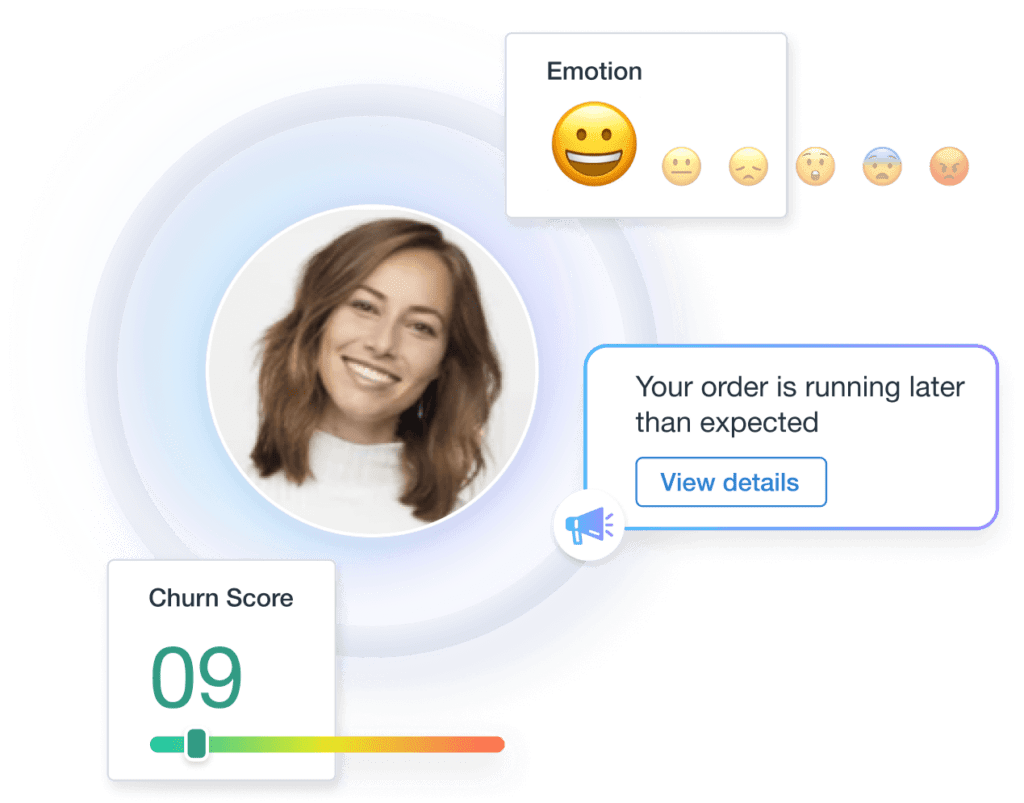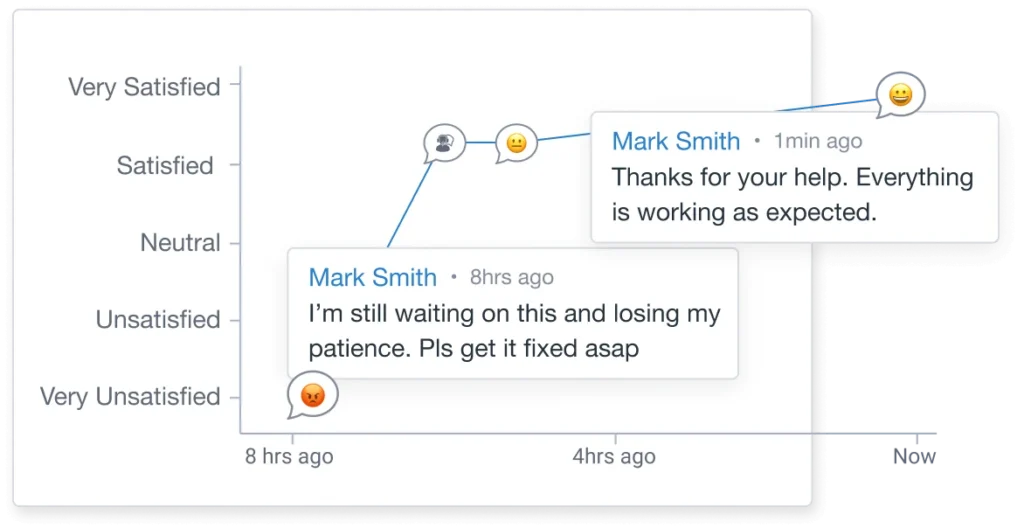What is Customer Sentiment?
Did you know that customer sentiment is fragile? Most customers are just a few negative experiences away from switching their loyalty and spending to a competitor.
Customer sentiment refers to the emotions and feelings customers have about your brand, which can significantly influence their buying behaviors and loyalty. It encompasses the overall perception derived from customer interactions, feedback, and social media discussions about your services or products.
Research underscores the importance of this issue: To improve customer retention rates, it’s crucial to consistently monitor and analyze qualitative customer service metrics, including customer sentiment. Understanding and responding to these emotions effectively can help prevent customers from turning to competitors and encourage lasting loyalty.
How Can Sentiment Analysis Be Used to Improve Customer Experience?
Customer sentiment serves as a key performance indicator (KPI) in customer service metrics, measuring how customers feel about your brand. It assists you in assessing the overall emotions of people who utilize your product or service, gauging their sentiments based on what they’re expressing and how they’re engaging.
The general measurements of customer sentiment are positive, negative, and neutral. However, you can attain a more granular view through intelligent, customer sentiment analysis models and tools. These tools leverage AI technologies like machine learning, Natural Language Processing (NLP), Natural Language Understanding (NLU), and Natural Language Generation (NLG) to monitor and analyze customer interactions comprehensively. Rather than measuring individual customer opinions, sentiment analysis provides an aggregate view of feelings, opinions, and attitudes toward your brand.
For instance, if 90 out of 100 interactions are positive, the overall sentiment is considered positive, despite some negative or neutral interactions. This aggregate approach helps gauge the general mood associated with your brand and the quality of the customer service experience.
Sentiment is measured using software that collects and analyzes data from customer satisfaction surveys, feedback, and expectations throughout their lifecycle. Platforms like Aisera’s AI-powered Support Intelligence (AISI) sift through vast amounts of data to extract crucial insights about customer health, sentiment, and satisfaction.
Based on these data points, companies can get a firm feel for their current situation, as well as opportunities for improvement. (More on how to improve customer sentiment appears in the latter half of this article.)

Why Customer Sentiment Matters
Now that you have a sense of the nature of customer sentiment, let’s discuss why it matters. Here are several reasons why customer sentiment analysis is important:
- Customer service: Did you know that one out of every three customers will leave your brand and choose a competitor after a single bad experience? Or that 64 percent of consumers stop doing business with a brand after two or three negative experiences? (Talk about fickle!) By focusing on customer sentiment, you can zero in on when and where bad experiences happen and correct them before they become widespread. An emphasis on customer sentiment will lead to delivering excellent customer service.
- Revenue: Customers who are happy and satisfied with your brand spend more than customers who are not. This means high customer sentiment leads to higher revenue over time.
- Loyalty: When customers are happy and continue to have positive interactions with your brand, they have no reason to jump ship in favor of one of your competitors. Even if other firms promote newer or cheaper offerings, your people will tend to stick with the brand they already know, like, and trust.
- Exposure: Research shows customers talk to their friends, colleagues, neighbors, and loved ones about their experiences with brands (positive, negative, or neutral). About 50 percent of customers share their experiences on social media, but as much as 72 percent actually talk about them in person. That same rate of people (72 percent) will tell six or more others about their positive experiences. Just 13 percent of customers will recommend a company with poor customer service.
- Marketing and innovation: Another benefit of having your finger on the pulse of your company’s customer sentiment is that you may unearth new opportunities. Your customers will tell you what they like and don’t like. They may even expose you to different desires and pain points of which you were not aware. This can guide you to develop new marketing campaigns, innovation, and creative product development.
The above is just the low-hanging fruit. The more you study customer sentiment, the more it’ll have a positive impact on your business and brand. The key is to keep your finger constantly on the pulse.
Customer Sentiment Analysis
Understanding Customer Feelings: Customer sentiment analysis is like a special lens that lets us see not just what customers say, but how they feel.
By using smart computer programs, we can look at the words and phrases customers use to talk about us, whether it’s on social media, in reviews, or when they get in touch with our team. This helps us pick up on their feelings—whether they’re happy, sad, or somewhere in between.
How to Measure Customer Sentiment
Measuring customer sentiment is like taking the temperature of how customers feel about your brand. It’s about finding out if they’re happy, unhappy, or indifferent. To get this and track customer sentiment information, you can look at:
- Surveys and Feedback Forms: Ask customers directly how they feel after they buy something or use your service. You can use scores, like on a scale from 1 to 10, to see how good or bad they think their experience was.
- Online Reviews and Ratings: Websites like Yelp, Google, and Amazon let customers leave reviews. By reading these and looking at the star ratings, you can get a sense of what customers think.
- Social Media Monitoring: Tools like Hootsuite or Sprout Social can check what people are saying about you on social media. They can tell if comments are generally positive, negative, or neutral.
- Customer Support Interactions: Listen to what customers say when they call or chat with your support team. Are they usually happy with the help they get, or are they frustrated?
- Sales Data: Happy customers tend to buy more and come back often. So, if you see an increase in sales or repeat customers, it can mean they feel good about your brand.
By combining all this data, you get a clearer picture of customer sentiment. It’s important to keep track of changes over time, too. If the customer sentiment data is getting better, you’re probably doing things right. If it’s getting worse, it might be time to find out why and make some changes.
Sentiment Analysis Tools
Customer sentiment analysis tools are software systems that help businesses understand how their customers feel by analyzing the language and emotions expressed in various forms of communication.
These tools can scan through large volumes of text from social media posts, reviews, and customer feedback to detect positive, negative, or neutral sentiments.
There are many customer sentiment analysis tools available in the market. We will mention two of the popular ones here. Let’s take a look at these sentiment analysis tools:
- Talkwalker: This tool scans online content to track what people say about your brand, using artificial intelligence to figure out if comments are positive, negative, or neutral.
- Awario: Awario finds brand mentions in real-time across the web and social media, analyzing the context to determine customer sentiment and helping you engage with customers directly.
- Aisera’s AI Support intelligence: Aisera delivers real-time sentiment and emotion insights in the AI support intelligence. It autonomously detects customer sentiment, tone, and emotion across live or offline support channels. This proactive approach predicts and prevents customer escalations, aiding in customer retention.

Use Cases of Customer Sentiment Analysis
Understanding how customers feel about your services or products can be a game-changer for your business. By analyzing customer sentiment, you can catch and address issues early, enhance customer satisfaction, and build stronger relationships with your customers.
For instance, it can help predict customer churn, tailor marketing campaigns more effectively, and even influence stock prices for publicly traded companies by customer sentiment analytics providing insights into public perception.
Customer Sentiment Analysis Can Help Your Support Team Do Better
When your support team knows how customers feel, they can respond more effectively. Sentiment analysis can identify the most critical cases that need immediate attention, helping your team prioritize their workload.
It also provides insight into common pain points, enabling your team to address them proactively. With this information, support staff can tailor their approach to each customer, leading to better service experiences and more resolved cases.
Customer Sentiment Can Guide Improvements to Products and Services
Customer sentiment is a compass that points to what’s working well and what’s not in your products and services. By tracking how customers react to different aspects of your offerings, you can identify areas for improvement or innovation.
This feedback is invaluable for product development teams, guiding them to make changes that resonate with customers and meet their needs more effectively. Positive and negative sentiments can also highlight strengths to be emphasized in marketing and sales strategies.
How to Improve Customer Sentiment
The great thing about customer sentiment is that it’s malleable. If your overall customer sentiment score is low, you can raise it over time. Here are several ways to make this happen.
1. Start With a Baseline
It’s difficult to improve something if you don’t have a clear read on where matters stand at the current moment. Which is to say you need a baseline measurement. In terms of tracking customer sentiment, this means taking the time to collect and analyze the data. Our AI Support Intelligence platform is perfect for this.
2. Empower Your Employees
One of the best things you can do for your overall customer experience (and employee experience) is to empower your customer service representatives to make decisions that could have a positive impact on customer loyalty and sentiment.
For example, try cutting back on the number of approvals customer service reps are required to obtain in order to make customers happy. If it’s a small issue that’s only going to cost the company a few dollars (but which would increase the chances of retaining that customer), this should be a no-brainer.
Your customer service team ought to be empowered to facilitate these actions directly on a call without having to put the customer through a long hold time. Find a dollar amount you’re comfortable with (whether it’s $40 or $200) and give your employees the freedom to make judgment calls on decisions that are below the threshold.
3. Personalize Customer Interactions
Customers love to feel special. Anything you can do to make them feel as if they’re being treated as an individual, not just other customers, will enhance the overall customer experience, and produce better customer sentiment numbers.
There’s power in personalization. Here are some examples of ways you can personalize interactions:
- Use customer data (like names and locations) to customize emails and marketing materials.
- Offer recommendations on future purchases based on past purchase activity.
- Use ad retargeting to personalize how, when, and where you deliver ads to customers who already interact with your brand.
- Develop a dynamic website experience that serves customers unique content based on their data.
Personalization is becoming far more common in the digital marketing world. You should be doing some personalization just to keep up. But anything you can do beyond the basics will help you stand out from the crowd.
4. Gather and Apply Feedback
The final suggestion is to gather feedback proactively from customers. You can do this via polls, surveys, one-on-one conversations, social media, and so on.
As you gather feedback, look for opportunities to leverage the insights. Not only will this help you improve your products and services, but it also shows customers you truly value their opinions to deliver great customer service every single time. You can chalk this up as another win in the positive customer sentiment column!
Aisera for Customer Sentiment Analysis
Want to learn more about how you can use Aisera to empower employees to put customers first? Interested in identifying easy ways to elevate your customer sentiment by strengthening the customer experience with AI? Request a free AI demo today!

